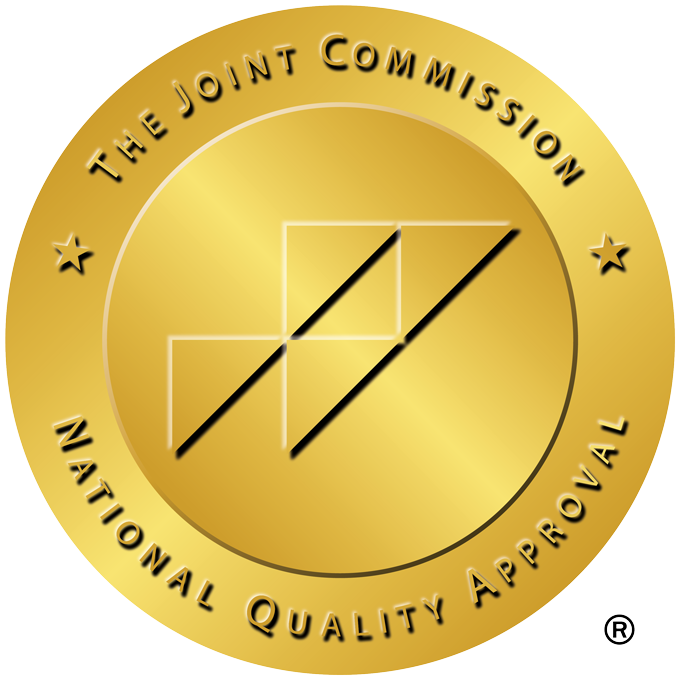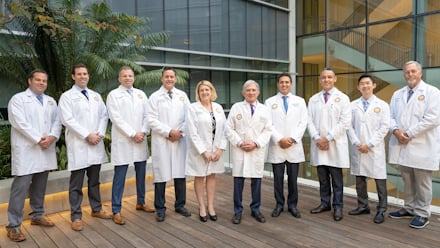Orthopedic Spine Care
Look to UC San Diego Health orthopedists to treat your back pain.
We have some of the nation's top spine surgeons, physiatrists and anesthesiologists, and are ranked among the top 50 in the nation for orthopedic care by U.S. News & World Report. We're also recognized as a Center of Excellence for complex spine care by Optum.
Recognized for High-Quality Care
The quality of our comprehensive spine care is recognized with The Joint Commission's Gold Seal of Approval for Advanced Certification in Spine Surgery (ACSS). This honor is based on our commitment to providing safe and excellent care. We are the first health organization in California to receive this advanced certification.
Skilled in therapeutic and diagnostic care, our team will help you overcome your spine condition using the most advanced surgical and nonsurgical treatment options available.

Nonsurgical Spine Treatment
Developing improved treatments for addressing spine conditions is a cornerstone of our work. Through our research programs, we explore advanced procedures, technologies, devices and medications, and provide patients access to clinical trials of new therapies.
Spinal conditions our specialists treat include:
- Sciatica
- Herniated discs
- Spinal stenosis
- Cervical stenosis
- Arthritis
- Spinal fractures
- Spinal tumors
- Spinal infections
- Adult scoliosis
Most spinal conditions don’t require surgery. Our team will work with you to utilize nonsurgical solutions when possible. These treatments may include therapeutic exercise, injection therapy and medications.
Back pain that occurs along the spine can often be treated without surgery.
Common nonsurgical treatments include:
- Anti-inflammatory medications (over-the-counter or prescription)
- Short-term bed rest (two to five days)
- Activity alteration
- Injections
By combining non-operative therapeutic methods with a customized physical therapy program, our physiatrists can treat patients' specific conditions such as herniated discs, arthritis, musculoskeletal injuries, and low back and neck pain.
Spine Surgery
Patients who need surgery are in good hands at UC San Diego Health. We have nationally recognized spine surgeons. Their expertise includes:
- Minimally invasive surgical procedures for vertebral fractures
- Lateral minimally invasive approaches for anterior lumbar interbody fusions (XLIF or DLIF) for degenerative conditions, scoliosis and trauma
- Cervical, thoracic, lumbar and lumbosacral intervertebral disc removal
- Spinal cord injuries
- Vertebral hemangiomas
- Spinal tumors
- Spinal stenosis
Minimally Invasive Spine Surgery
The field of spinal surgery is being transformed by minimally invasive surgical techniques. We are at the forefront of innovations in minimally invasive spinal surgery, providing a broad range of therapies for spinal disorders and injuries.
Minimally invasive procedures include:
- Kyphoplasty
- Endoscopic surgery for disc disease and spine motion preservation
- Fusion
- Decompressive techniques
We use specialized instruments to decrease the incision size and reduce injury to surrounding tissue. This results in less pain, quicker recovery, and improved functioning.
Patients who are candidates for minimally invasive treatment include those with:
- Chronic sacroiliac (SI) joint dysfunction
- Herniated discs
- Infections
- Kyphosis
- Scoliosis
- Spinal fractures
- Spinal stenosis
- Spondylolisthesis
- Tumors
Open Spine Surgery
Some spinal conditions require open or traditional surgery to give the surgeon appropriate access to the spine.
Conditions that may require open surgery include:
- Degenerative osteoarthritis
- Fractures
- Scoliosis
- Infections
- Tumors
Advances in computer and imaging technologies provide our surgeons with the ability to have extended vision of the patient's spine during surgery. This helps guide the surgeons to critical areas of the spine, minimizing disruption of nearby muscles, tissues, nerves and blood vessels.
Total Disc Replacement
During total disc replacement, a degenerative disc is replaced with an artificial disc.
Advantages of total disc replacement over a conventional spinal fusion:
- Shorter recovery time
- Reduced postoperative discomfort
- Most patients can return to normal and full-motion activities within six weeks (compared to 3-6 months after a fusion procedure)
UC San Diego Health spine surgeons have been involved with the development of some of these surgical techniques, as well as many clinical trials.
Spine Classes
Learn more about what to expect before and after your spine surgery. Classes are taught via Zoom videoconferencing by our multidisciplinary inpatient spine team which includes nurses, physical therapists, occupational therapists and care managers. You'll have the opportunity to ask questions so that you feel comfortable with your spine surgery.
See more spine class details in our Classes and Events Calendar
Groundbreaking Procedure Uses Augmented Reality
Our spine surgeons are the first on the West Coast to use a form of augmented reality during surgery.
The three-dimensional navigation system and headset allow surgeons to visualize inside the body. This helps them quickly and accurately place implants in each patient’s unique anatomy, decreasing time on the operating table and increasing safety.
Orthopedic Surgeons
Find an orthopedic surgeon who specializes in spine care.



